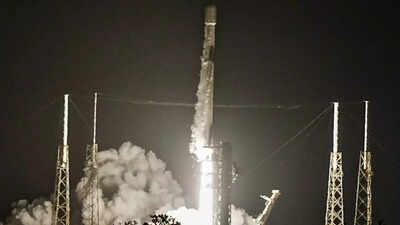Early on June 28th, SpaceX successfully launched a Falcon 9 rocket carrying 27 Starlink satellites from Cape Canaveral Space Force Station in Florida. The launch, which took place at 12:26 a.m. from Launch Complex 40, followed a day of severe weather warnings.

Meteorologists had issued multiple thunderstorm alerts and lightning watches, potentially delaying the mission. However, the skies cleared, providing the launch team with calm conditions, 10-mile visibility, and optimal weather.
This mission contributes to SpaceX's growing Starlink constellation, designed to deliver global broadband internet coverage, particularly to underserved areas. The launch also coincided with the 10th anniversary of a Falcon 9 rocket explosion during a NASA resupply mission to the International Space Station on June 28, 2015. The contrast highlights SpaceX's significant technological and operational advancements.
The Falcon 9 rocket used for this launch had already completed several missions. SpaceX confirmed that the first-stage booster was on its fifth flight, previously launching CRS-32, NROL-69, GPS III-7, and another Starlink deployment. After delivering the payload into low-Earth orbit, the booster successfully landed on the SpaceX drone ship A Shortfall of Gravitas, located in the Atlantic Ocean.
This display of reusability showcases the economic and environmental benefits of SpaceX's design. Recovering boosters reduces the cost of future missions and supports SpaceX’s vision of sustainable space travel and interplanetary missions.
June 28th also carries historical significance for SpaceX. On this day in 2015, a Falcon 9 rocket carrying a SpaceX Dragon capsule for NASA broke apart shortly after launch. The explosion was a major setback but became a crucial learning experience that shaped the company's approach to reliability and design.
The recent launch occurred under the supervision of Col. Brian Chatman, the new commander of Space Launch Delta 45, overseeing operations at Patrick Space Force Base and the Eastern Range. Chatman is responsible for safety across a 15-million-square-mile operational area. The success of this mission reflects technical coordination and operational precision during a period of increasing launch activity.
Newer articles
Older articles
 Chess Star Praggnanandhaa Weighs In on Carlsen's Frustration After Loss to Gukesh
Chess Star Praggnanandhaa Weighs In on Carlsen's Frustration After Loss to Gukesh
 Samsung Galaxy A35 5G and A55 5G: Official Pricing and Availability Announced
Samsung Galaxy A35 5G and A55 5G: Official Pricing and Availability Announced
 India's Fielding Woes Blamed for First Test Defeat Against England: Former Selector Voices Concerns
India's Fielding Woes Blamed for First Test Defeat Against England: Former Selector Voices Concerns
 Headline: Viral Optical Illusion: Can You Find All the Hidden Animals? Only 1% Succeed
Headline: Viral Optical Illusion: Can You Find All the Hidden Animals? Only 1% Succeed
 Shadman Stands By Bangladesh Batters After Day 1 Struggles Against Sri Lanka
Shadman Stands By Bangladesh Batters After Day 1 Struggles Against Sri Lanka
 Norris Claims Thrilling Austrian GP Victory After Intense Duel with McLaren Teammate Piastri
Norris Claims Thrilling Austrian GP Victory After Intense Duel with McLaren Teammate Piastri
 Jake Paul's Title Dreams: Analyzing Championship Prospects and Potential Opponents
Jake Paul's Title Dreams: Analyzing Championship Prospects and Potential Opponents
 Gavaskar Urges India to Unleash Kuldeep Yadav in Second Test Amid Bumrah Fitness Concerns
Gavaskar Urges India to Unleash Kuldeep Yadav in Second Test Amid Bumrah Fitness Concerns
 iQoo Z9 Turbo Leaks: Snapdragon 8s Gen 3, 1.5K Display, and Massive Battery Detailed
iQoo Z9 Turbo Leaks: Snapdragon 8s Gen 3, 1.5K Display, and Massive Battery Detailed
 Mirabai Chanu Reveals Relentless Dedication: Training and Weight Always Top of Mind, Even During Family Time
Mirabai Chanu Reveals Relentless Dedication: Training and Weight Always Top of Mind, Even During Family Time